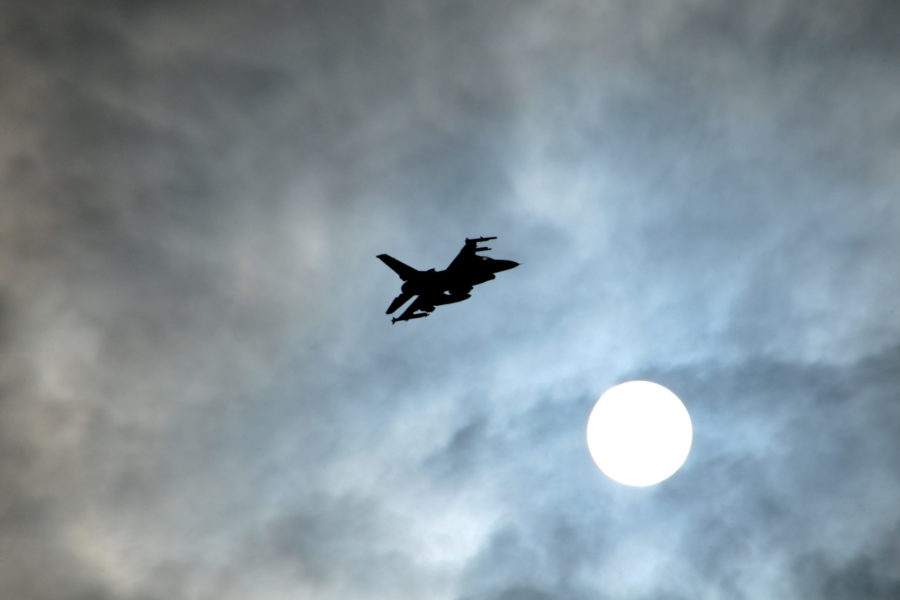RAMSTEIN AIR BASE, Germany—Ukraine is calling for modern American fighter jets to face Russia’s overwhelming air advantage in the contested skies over the war-torn country, but senior Air Force officials say American F-16s, which require lengthy training, are not yet part of the aid picture.
More than 40 nations gathered at Ramstein Air Base, Germany, on April 26 to consider what type of weapons to supply, including air power assistance such as F-16s, to Ukraine. The war is now shifting to the eastern front in the Donbas region, an area where long-range weapons are desperately needed.
Recently, however, the Ukrainian Air Force has expanded its request beyond Soviet-era jets they already know how to fly, such as MiG-29s and Su-24s. Ukraine is asking for modern American jets, including F-15s, F-16s, and “maybe” F-18s, to shift the air advantage to their side, according to a video posted on the Ukrainian Air Force Twitter page April 26, the day of the Ramstein meeting.
Senior defense officials, including U.S. Air Forces in Europe commander Gen. Jeffrey L. Harrigian, spoke about the possibility of supplying American-made F-16s to Ukraine.
“That doesn’t happen fast,” Harrigian told Air Force Magazine during a pull-aside interview at the Ramstein Officer’s Club where the meeting was taking place.
“At the end of the day, we’ve got to leverage what they have and offer them some other unique capabilities to make the problem challenging, and then there’s the longer-term view,” he added. “Clearly, they want to migrate from Russian capabilities to U.S., but that takes some time.”
On March 8, Poland offered to transfer its inventory of 23 MiG-29s to Ramstein, for the United States to give to Ukraine. The suggestion, made publicly by Poland’s foreign minister, was turned down by the Defense Department. Commander of U.S. European Command Air Force Gen. Tod. D. Wolters later issued a statement saying the move could be seen as “escalatory.”
Polish Defense Minister Mariusz Błaszczak told Air Force Magazine that making the MiG delivery would now require a consensus among NATO nations.
“It should be a decision taken by all [the] alliance, the NATO alliance,” Błaszczak said during a pull-aside interview before the start of the Ramstein meeting.
“I’m sure that more defense assistance is needed for Ukraine,” he said, adding that he believed the meeting would provide an avenue for getting more weapons to Ukraine. “My opinion, this meeting is a success, and it’s a very good initiative. So, I’m optimistic.”
Ukrainian officials have said their Soviet-era jets are not enough to evade modern Russian weapons.
“To effectively protect our territory, Ukraine requires at least one squadron of modern fighter jets, such as American-made F-16s or F-15s,” former commander of the Ukrainian Air Force Serhii Drozdov wrote in an April 19 opinion piece.
“According to our estimates, our pilots can learn to fly such jets at an accelerated pace of two to three weeks,” he added.
That’s an extremely accelerated timeline. The Basic course at the F-16 schoolhouse at Luke Air Force Base, Ariz., takes about 9 months and includes academics, simulation training, and flight sorties. But even before students arrive at Luke, they must complete six months of basic flight training in the T-6, seven months in the T-38, and six to eight weeks learning basic fighter fundamentals and advanced fighter maneuvers in the AT-38.
Drozdov said the Soviet-made Polish MiGs had received some upgrades to meet NATO standards but that they still have “outdated radar and missile technologies.”
“Pilots would continue to be sitting ducks in these planes—easy targets for the enemy,” he wrote.
The U.S. Air Force’s 2023 budget plans to retire more than 200 F-15s, but the Air Force considers the aircraft to be beyond their useful service life, and in some cases, the aircraft have safety of flight issues and can no longer fly.
At an April 28 background briefing, a senior defense official told Air Force Magazine that the United States continues to provide or facilitate the transfer of Soviet-era spare parts to keep Ukrainian jets flying.
“This is an air force that relies principally on old Soviet aircraft. That’s what they’re used to flying. That’s what they’ve got in their fleet. That’s what we’re trying to help them keep in the air,” the official said. “I’m not going to speculate about the future of aircraft deliveries one way or the other.”
At a Ramstein background briefing, defense officials revealed that a variety of training activities are taking place in Germany and other countries outside of Ukraine.
The senior defense official said April 28 that the trainings are typically short, such as the six-day training for how to use Howitzers, enabling fighters to quickly return to the front line.
Still, a defense official from the EUCOM Control Center Ukraine (ECCU) at EUCOM headquarters in Stuttgart, Germany, said at a Ramstein background briefing for journalists that enhancing Ukraine’s air power was a topic of conversation at Ramstein.
Harrigian confirmed that air power conversations were going on, but he cautioned that training on American jets might be a step too far.
“Collectively, we’ve got to step up and understand what the Ukrainians’ requirements are and find a way to get it to them and get it to them quick,” Harrigian said.
“You just don’t throw somebody an F-16 and wish them good luck,” he said. “That is not a recipe for success, and we want to set them up for success.”


